Electrophoretic Determination of Symmetric and Asymmetric Dimethylarginine in Human Blood Plasma with Whole Capillary Sample Injection
Abstract
:1. Introduction
2. Results and Discussions
2.1. Electrophoretic Stacking with Whole Capillary Sample Injection
2.2. Determining ADMA and SDMA in Human Plasma
2.3. Comparison of Electrophoretic Determination of ADMA and SDMA
3. Materials and Methods
3.1. Chemicals, Model Sample and Plasma Sample Preparation
3.2. Electrophoretic Apparatus
3.3. PAMAPTAC-Coated Capillary
3.4. Electrophoretic Stacking Coupled with Whole Capillary Filling by the Sample
- A vial with the sample is connected to the entrance into the capillary and a vial filled with BGE for the waste is connected to the exit from the capillary, and application of a pressure of 940 mbar for 2 min leads to filling of the whole capillary with the sample.
- The exit vial is exchanged for a vial with clean BGE and BGE with a length of 18.0 mm is forced to the exit end of the capillary by application of a vacuum impulse of −50 mbar for 2 min. The sample in the capillary has a length of 376.5 mm, corresponding to 95.4% of the overall length of the capillary.
- A vial containing BGE is placed at the entrance and the separation voltage of +30 kV, with a ramp of 0.2 min, is turned on. Methylarginines migrate in the cathodic direction towards the detection end of the capillary in the electric field. BGE is drawn out of the end of the electrophoretic vial into the capillary through the action of the anodic EOF and the EOF simultaneously forces the residual sample matrix out of the capillary into the entrance vial. Methylarginines are first isotachophoretically sharpened to the base of the long zone of the sodium ions (the most abundant cations in blood plasma) by the mechanism of transient pseudo-isotachophoresis [55,58], where sodium acts as leading ion and solvent ACN provide the high field strength necessary for analyte sharpening, similar to that provided by the terminating ion. Then, after the zone of sodium ions with the sharpened methylarginines moves out of the sample area into the BGE, the separation mechanism switches to the capillary zone electrophoresis regime (CZE) and the individual zones are separated.
- After the end of the separation, a vial with fresh BGE is connected to the entrance and a vial for waste is connected to the exit. The capillary is then rinsed by a pressure of 940 mbar for 5 min.
4. Conclusions
Author Contributions
Funding
Institutional Review Board Statement
Informed Consent Statement
Data Availability Statement
Acknowledgments
Conflicts of Interest
Appendix A
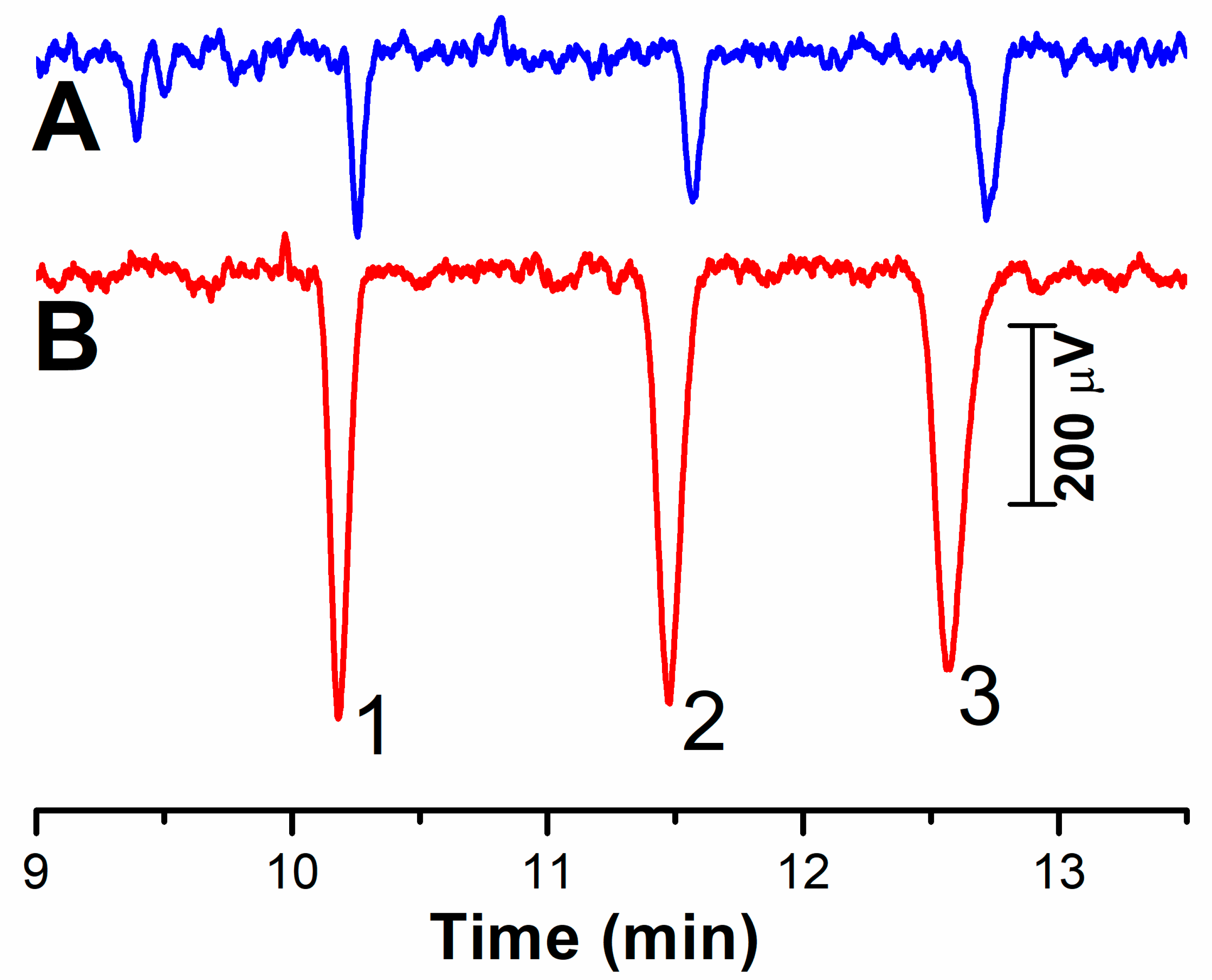
References
- Gary, J.D.; Clarke, S. RNA and protein interactions modulated by protein arginine methylation. Prog. Nucleic Acid Res. Mol. Biol. 1998, 61, 65–131. [Google Scholar] [CrossRef] [PubMed]
- Bedford, M.T.; Clarke, S.G. Protein Arginine Methylation in Mammals: Who, What, and Why. Mol. Cell 2009, 33, 1–13. [Google Scholar] [CrossRef] [PubMed] [Green Version]
- Carlson, S.M.; Gozani, O. Emerging Technologies to Map the Protein Methylome. J. Mol. Biol. 2014, 426, 3350–3362. [Google Scholar] [CrossRef] [PubMed] [Green Version]
- Ogawa, T.; Kimoto, M.; Sasaoka, K. Occurrence of a new enzyme catalyzing the direct conversion of NG,NG-dimethyl-L-arginine to L-citrulline in rats. Biochem. Biophys. Res. Commun. 1987, 148, 671–677. [Google Scholar] [CrossRef]
- Achan, V.; Broadhead, M.; Malaki, M.; Whitley, G.; Leiper, J.; MacAllister, R.; Vallance, P. Asymmetric dimethylarginine causes hypertension and cardiac dysfunction in humans and is actively metabolized by dimethylarginine dimethylaminohydrolase. Arterioscler. Thromb. Vasc. Biol. 2003, 23, 1455–1459. [Google Scholar] [CrossRef] [PubMed] [Green Version]
- Vallance, P.; Leone, A.; Calver, A.; Collier, J.; Moncada, S. Accumulation of an endogenous inhibitor of nitric-oxide synthesis in chronic-renal-failure. Lancet 1992, 339, 572–575. [Google Scholar]
- Marescau, B.; Nagels, G.; Possemiers, I.; DeBroe, M.E.; Becaus, I.; Billiouw, J.M.; Lornoy, W.; DeDeyn, P.P. Guanidino compounds in serum and urine of nondialyzed patients with chronic renal insufficiency. Metab. Clin. Exp. 1997, 46, 1024–1031. [Google Scholar] [CrossRef]
- Blackwell, S. The biochemistry, measurement and current clinical significance of asymmetric dimethylarginine. Ann. Clin. Biochem. 2010, 47, 17–28. [Google Scholar] [CrossRef]
- Siroen, M.P.C.; Teerlink, T.; Nijveldt, R.J.; Prins, H.A.; Richir, M.C.; van Leeuwen, P.A.M. The clinical significance of asymmetric dimethylarginine. Annu. Rev. Nutr. 2006, 26, 203–228. [Google Scholar] [CrossRef] [PubMed] [Green Version]
- Tain, Y.L.; Hsu, C.N. Interplay between Oxidative Stress and Nutrient Sensing Signaling in the Developmental Origins of Cardiovascular Disease. Int. J. Mol. Sci. 2017, 18, 841. [Google Scholar] [CrossRef]
- Cooke, J.P. The pivotal role of nitric oxide for vascular health. Can. J. Cardiol. 2004, 20, 7B–15B. [Google Scholar]
- Steyers, C.M.; Miller, F.J. Endothelial Dysfunction in Chronic Inflammatory Diseases. Int. J. Mol. Sci. 2014, 15, 11324–11349. [Google Scholar] [CrossRef] [PubMed] [Green Version]
- Grosse, G.M.; Schwedhelm, E.; Worthmann, H.; Choe, C.U. Arginine Derivatives in Cerebrovascular Diseases: Mechanisms and Clinical Implications. Int. J. Mol. Sci. 2020, 21, 1798. [Google Scholar] [CrossRef] [PubMed] [Green Version]
- Boger, R.H.; Bode-Boger, S.M.; Szuba, A.; Tsao, P.S.; Chan, J.R.; Tangphao, O.; Blaschke, T.F.; Cooke, J.P. Asymmetric dimethylarginine (ADMA): A novel risk factor for endothelial dysfunction—Its role in hypercholesterolemia. Circulation 1998, 98, 1842–1847. [Google Scholar] [CrossRef] [PubMed] [Green Version]
- Sydow, K.; Mondon, C.E.; Cooke, J.P. Insulin resistance: Potential role of the endogenous nitric oxide synthase inhibitor ADMA. Vasc. Med. 2005, 10, S35–S43. [Google Scholar] [CrossRef] [Green Version]
- Jacobi, J.; Tsao, P.S. Asymmetrical dimethylarginine in renal disease: Limits of variation or variation limits? Am. J. Nephrol. 2008, 28, 224–237. [Google Scholar] [CrossRef] [Green Version]
- Rysz, J.; Gluba-Brzozka, A.; Franczyk, B.; Jablonowski, Z.; Cialkowska-Rysz, A. Novel Biomarkers in the Diagnosis of Chronic Kidney Disease and the Prediction of Its Outcome. Int. J. Mol. Sci. 2017, 18, 1702. [Google Scholar] [CrossRef]
- Surdacki, A.; Nowicki, M.; Sandmann, J.; Tsikas, D.; Boeger, R.H.; Bode-Boeger, S.M.; Kruszelnicka-Kwiatkowska, O.; Kokot, F.; Dubiel, J.S.; Froelich, J.C. Reduced urinary excretion of nitric oxide metabolites and increased plasma levels of asymmetric dimethylarginine in men with essential hypertension. J. Cardiovasc. Pharmacol. 1999, 33, 652–658. [Google Scholar] [CrossRef]
- Tain, Y.L.; Hsu, C.N. Targeting on Asymmetric Dimethylarginine-Related Nitric Oxide-Reactive Oxygen Species Imbalance to Reprogram the Development of Hypertension. Int. J. Mol. Sci. 2016, 17, 2020. [Google Scholar] [CrossRef] [Green Version]
- Cardounel, A.J.; Cui, H.M.; Samouilov, A.; Johnson, W.; Kearns, P.; Tsai, A.L.; Berka, V.; Zweier, J.L. Evidence for the pathophysiological role of endogenous methylarginines in regulation of endothelial NO production and vascular function. J. Biol. Chem. 2007, 282, 879–887. [Google Scholar] [CrossRef] [Green Version]
- Bode-Boger, S.M.; Scalera, F.; Kielstein, J.T.; Martens-Lobenhoffer, J.; Breithardt, G.; Fobker, M.; Reinecke, H. Symmetrical dimethylarginine: A new combined parameter for renal function and extent of coronary artery disease. J. Am. Soc. Nephrol. 2006, 17, 1128–1134. [Google Scholar] [CrossRef] [PubMed]
- Zhang, W.Z.; Kaye, D.M. Simultaneous determination of arginine and seven metabolites in plasma by reversed-phase liquid chromatography with a time-controlled ortho-phthaldialdehyde precolumn derivatization. Anal. Biochem. 2004, 326, 87–92. [Google Scholar] [CrossRef]
- Marra, M.; Bonfigli, A.R.; Testa, R.; Testa, I.; Gambini, A.; Coppa, G. High-performance liquid chromatographic assay of asymmetric dimethylarginine, symmetric dimethylarginine, and arginine in human plasma by derivatization with naphthalene-2,3-dicarboxaldehyde. Anal. Biochem. 2003, 318, 13–17. [Google Scholar] [CrossRef]
- Heresztyn, T.; Worthley, M.I.; Horowitz, J.D. Determination of L-arginine and N-G,N-G- and N-G,N-G ‘-dimethyl-L-arginine in plasma by liquid chromatography as AccQ-Fluor (TM) fluorescent derivatives. J. Chromatogr. B 2004, 805, 325–329. [Google Scholar] [CrossRef]
- Nonaka, S.; Tsunoda, M.; Imai, K.; Funatsu, T. High-performance liquid chromatographic assay of N-G-monomethyl-L-arginine, N-G-dimethyl-L-arginine, and (NNG)-N-G-dimethyl-L-arginine using 4-fluoro-7-nitro-2,1,3-benzoxaldiazole as a fluorescent reagent. J. Chromatogr. A 2005, 1066, 41–45. [Google Scholar] [CrossRef]
- Teerlink, T.; Nijveldt, R.J.; de Jong, S.; van Leeuwen, P.A.M. Determination of arginine, asymmetric dimethylarginine, and symmetric dimethylarginine in human plasma and other biological samples by high-performance liquid chromatography. Anal. Biochem. 2002, 303, 131–137. [Google Scholar] [CrossRef]
- Shin, S.; Fung, S.M.; Mohan, S.; Fung, H.L. Simultaneous bioanalysis of L-arginine, L-citrulline, and dimethylarginines by LC-MS/MS. J. Chromatogr. B 2011, 879, 467–474. [Google Scholar] [CrossRef] [PubMed] [Green Version]
- Schwedhelm, E.; Maas, R.; Tan-Andresen, J.; Schulze, F.; Riederer, U.; Boger, R.H. High-throughput liquid chromatographic-tandem mass spectrometric determination of arginine and dimethylated arginine derivatives in human and mouse plasma. J. Chromatogr. B 2007, 851, 211–219. [Google Scholar] [CrossRef] [PubMed]
- Sotgia, S.; Zinellu, A.; Paliogiannis, P.; Pinna, G.A.; Mangoni, A.A.; Milanesi, L.; Carru, C. A diethylpyrocarbonate-based derivatization method for the LC-MS/MS measurement of plasma arginine and its chemically related metabolites and analogs. Clin. Chim. Acta 2019, 492, 29–36. [Google Scholar] [CrossRef]
- Teerlink, T. HPLC analysis of ADMA and other methylated L-arginine analogs in biological fluids. J. Chromatogr. B 2007, 851, 21–29. [Google Scholar] [CrossRef] [PubMed]
- Martens-Lobenhoffer, J.; Bode-Boger, S.M. Mass spectrometric quantification of L-arginine and its pathway related substances in biofluids: The road to maturity. J. Chromatogr. B 2014, 964, 89–102. [Google Scholar] [CrossRef]
- Tsikas, D. A critical review and discussion of analytical methods in the L-arginine/nitric oxide area of basic and clinical research. Anal. Biochem. 2008, 379, 139–163. [Google Scholar] [CrossRef] [PubMed]
- Martens-Lobenhoffer, J.; Bode-Boger, S.A. Chromatographic-mass spectrometric methods for the quantification of L-arginine and its methylated metabolites in biological fluids. J. Chromatogr. B 2007, 851, 30–41. [Google Scholar] [CrossRef] [PubMed]
- Schwedhelm, E. Quantification of ADMA: Analytical approaches. Vasc. Med. 2005, 10, S89–S95. [Google Scholar] [CrossRef] [PubMed] [Green Version]
- Albsmeier, J.; Schwedhelm, E.; Schulze, F.; Kastner, M.; Boger, R.H. Determination of N-G,N-G-dimethyl-L-arginine, an endogenous NO synthase inhibitor, by gas chromatography-mass spectrometry. J. Chromatogr. B 2004, 809, 59–65. [Google Scholar] [CrossRef] [PubMed]
- Schulze, F.; Wesemann, R.; Schwedhelm, E.; Sydow, K.; Albsmeier, J.; Cooke, J.P.; Boger, R.H. Determination of asymmetric dimethylarginine (ADMA) using a novel ELISA assay. Clin. Chem. Lab. Med. 2004, 42, 1377–1383. [Google Scholar] [CrossRef]
- Causse, E.; Siri, N.; Arnal, J.F.; Bayle, C.; Malatray, P.; Valdiguie, P.; Salvayre, R.; Couderc, F. Determination of asymmetrical dimethylarginine by capillary electrophoresis-laser-induced fluorescence. J. Chromatogr. B 2000, 741, 77–83. [Google Scholar] [CrossRef]
- Zinellu, A.; Sotgia, S.; Zinellu, E.; Pinna, A.; Carta, F.; Gaspa, L.; Deiana, L.; Carru, C. High-throughput CZE-UV determination of airginine and dimethylated arginines in human plasma. Electrophoresis 2007, 28, 1942–1948. [Google Scholar] [CrossRef]
- Zinellu, A.; Sotgia, S.; Porcu, P.; Casu, M.A.; Bivona, G.; Chessa, R.; Deiana, L.; Carru, C. Carotid restenosis is associated with plasma ADMA concentrations in carotid endarterectomy patients. Clin. Chem. Lab. Med. 2011, 49, 897–901. [Google Scholar] [CrossRef]
- Zinellu, A.; Sotgia, S.; Scanu, B.; Deiana, L.; Carru, C. Determination of protein-incorporated methylated arginine reference values in healthy subjects whole blood and evaluation of factors affecting protein methylation. Clin. Biochem. 2008, 41, 1218–1223. [Google Scholar] [CrossRef]
- Zinellu, A.; Sotgia, S.; Usai, M.F.; Pintus, G.; Deiana, L.; Carru, C. Improved method for plasma ADMA, SDMA, and arginine quantification by field-amplified sample injection capillary electrophoresis UV detection. Anal. Bioanal. Chem. 2011, 399, 1815–1821. [Google Scholar] [CrossRef] [PubMed]
- Berlinguer, F.; Porcu, C.; Molle, G.; Cabiddu, A.; Dattena, M.; Gallus, M.; Pasciu, V.; Succu, S.; Sotgiu, F.D.; Paliogiannis, P.; et al. Circulating Concentrations of Key Regulators of Nitric Oxide Production in Undernourished Sheep Carrying Single and Multiple Fetuses. Animals 2020, 10, 65. [Google Scholar] [CrossRef] [Green Version]
- Desiderio, C.; Rossetti, D.V.; Messana, I.; Giardina, B.; Castagnola, M. Analysis of arginine and methylated metabolites in human plasma by field amplified sample injection capillary electrophoresis tandem mass spectrometry. Electrophoresis 2010, 31, 1894–1902. [Google Scholar] [CrossRef]
- Linz, T.H.; Snyder, C.M.; Lunte, S.M. Optimization of the Separation of NDA-Derivatized Methylarginines by Capillary and Microchip Electrophoresis. JALA 2012, 17, 24–31. [Google Scholar] [CrossRef] [Green Version]
- Linz, T.H.; Lunte, S.M. Heat-assisted extraction for the determination of methylarginines in serum by CE. Electrophoresis 2013, 34, 1693–1700. [Google Scholar] [CrossRef] [Green Version]
- Hauser, P.C.; Kubáň, P. Capacitively coupled contactless conductivity detection for analytical techniques—Developments from 2018 to 2020. J. Chromatogr. A 2020, 1632, 19. [Google Scholar] [CrossRef]
- Tůma, P. Determination of amino acids by capillary and microchip electrophoresis with contactless conductivity detection—Theory, instrumentation and applications. Talanta 2021, 224. [Google Scholar] [CrossRef] [PubMed]
- Tůma, P.; Samcová, E.; Štulík, K. Contactless conductivity detection in capillary electrophoresis employing capillaries with very low inner diameters. Electroanalysis 2011, 23, 1870–1874. [Google Scholar] [CrossRef]
- Tůma, P.; Hložek, T.; Sommerová, B.; Koval, D. Large volume sample stacking of antiepileptic drugs in counter current electrophoresis performed in PAMAPTAC coated capillary. Talanta 2021, 221, 8. [Google Scholar] [CrossRef]
- Tůma, P.; Koval, D.; Sommerová, B.; Vaculín, S. Separation of anaesthetic ketamine and its derivates in PAMAPTAC coated capillaries with tuneable counter-current electroosmotic flow. Talanta 2020, 217, 8. [Google Scholar] [CrossRef] [PubMed]
- Tůma, P.; Sommerová, B.; Vaculín, Š. Rapid electrophoretic monitoring of the anaesthetic ketamine and its metabolite norketamine in rat blood using a contactless conductivity detector to study the pharmacokinetics. J. Sep. Sci. 2019, 42, 2062–2068. [Google Scholar] [CrossRef]
- Tůma, P. Frequency-tuned contactless conductivity detector for the electrophoretic separation of clinical samples in capillaries with very small internal dimensions. J. Sep. Sci. 2017, 40, 940–947. [Google Scholar] [CrossRef]
- El-Debs, R.; Marechal, A.; Dugas, V.; Demesmay, C. Photopolymerization of acrylamide as a new functionalization way of silica monoliths for hydrophilic interaction chromatography and coated silica capillaries for capillary electrophoresis. J. Chromatogr. A 2014, 1326, 89–95. [Google Scholar] [CrossRef]
- El-Debs, R.; Dugas, V.; Demesmay, C. Photografting as a versatile, localizable, and single-step surface functionalization of silica-based monoliths dedicated to microscale separation techniques. J. Sep. Sci. 2013, 36, 993–1001. [Google Scholar] [CrossRef] [PubMed]
- Shihabi, Z.K. Transient pseudo-isotachophoresis for sample concentration in capillary electrophoresis. Electrophoresis 2002, 23, 1612–1617. [Google Scholar] [CrossRef]
- Shihabi, Z.K. Stacking of weakly cationic compounds by acetonitrile for capillary electrophoresis. J. Chromatogr. A 1998, 817, 25–30. [Google Scholar] [CrossRef]
- Shihabi, Z.K. Stacking in capillary zone electrophoresis. J. Chromatogr. A 2000, 902, 107–117. [Google Scholar] [CrossRef]
- Křivánková, L.; Pantůčková, P.; Boček, P. Isotachophoresis in zone electrophoresis. J. Chromatogr. A 1999, 838, 55–70. [Google Scholar] [CrossRef]
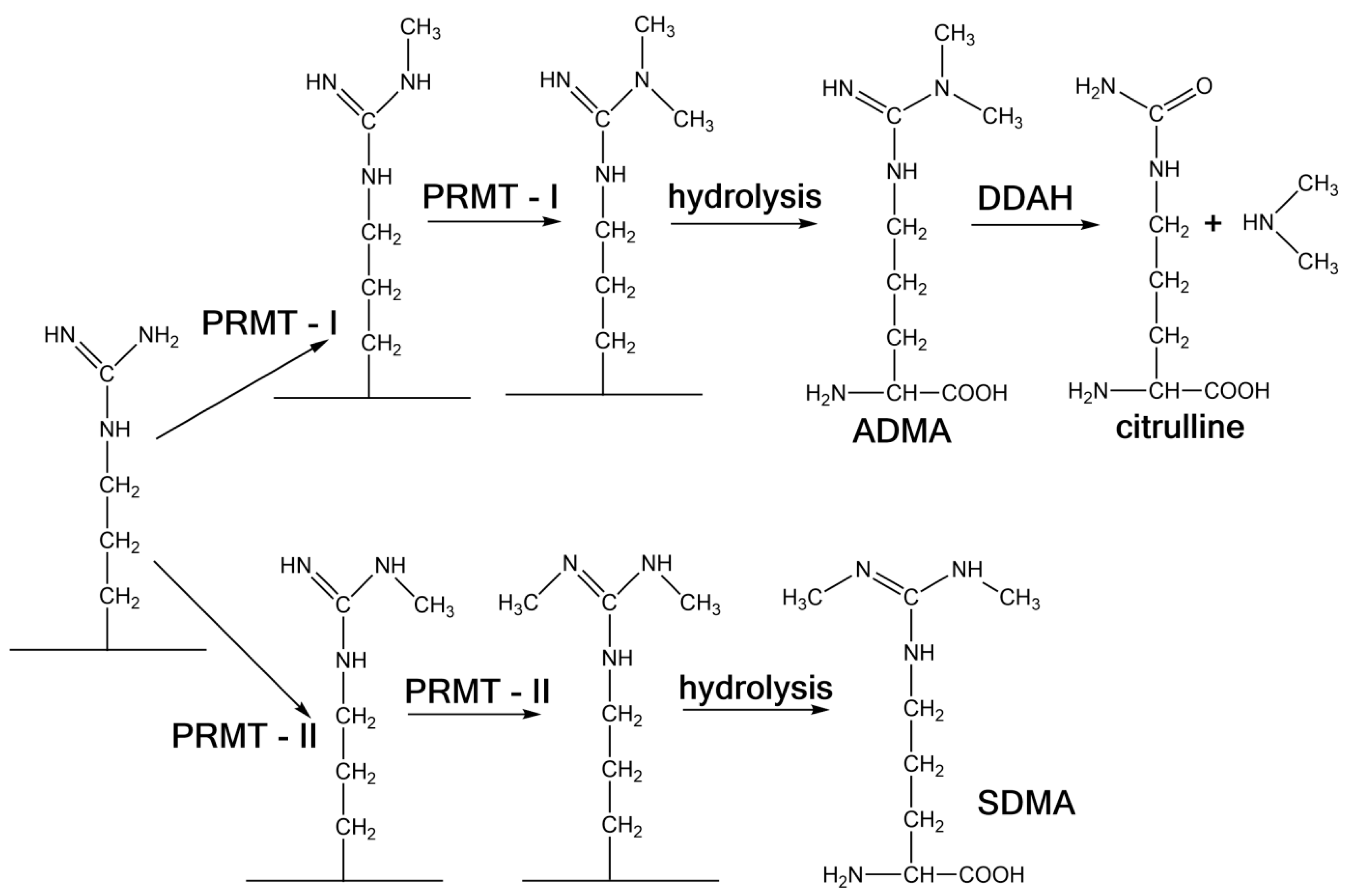
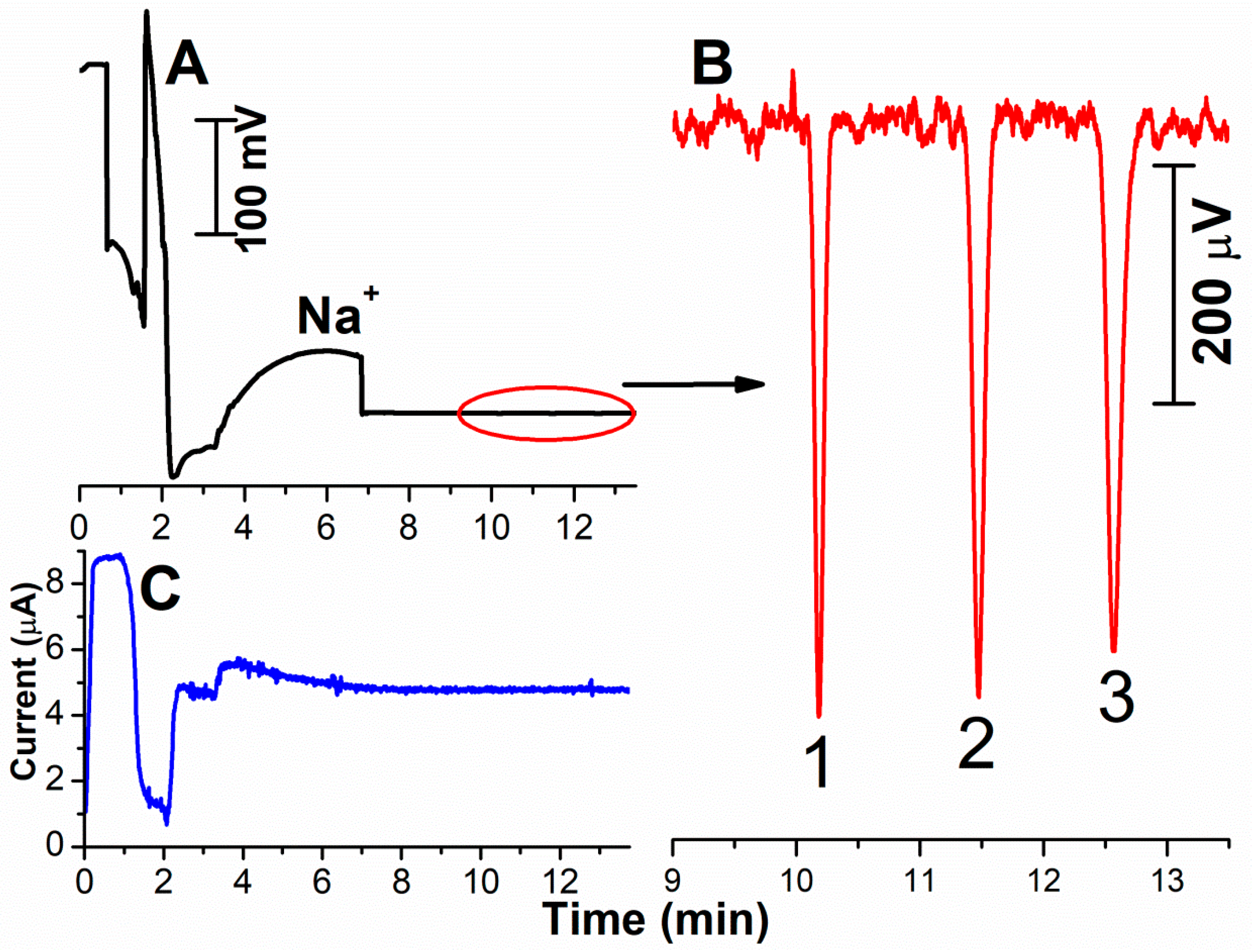
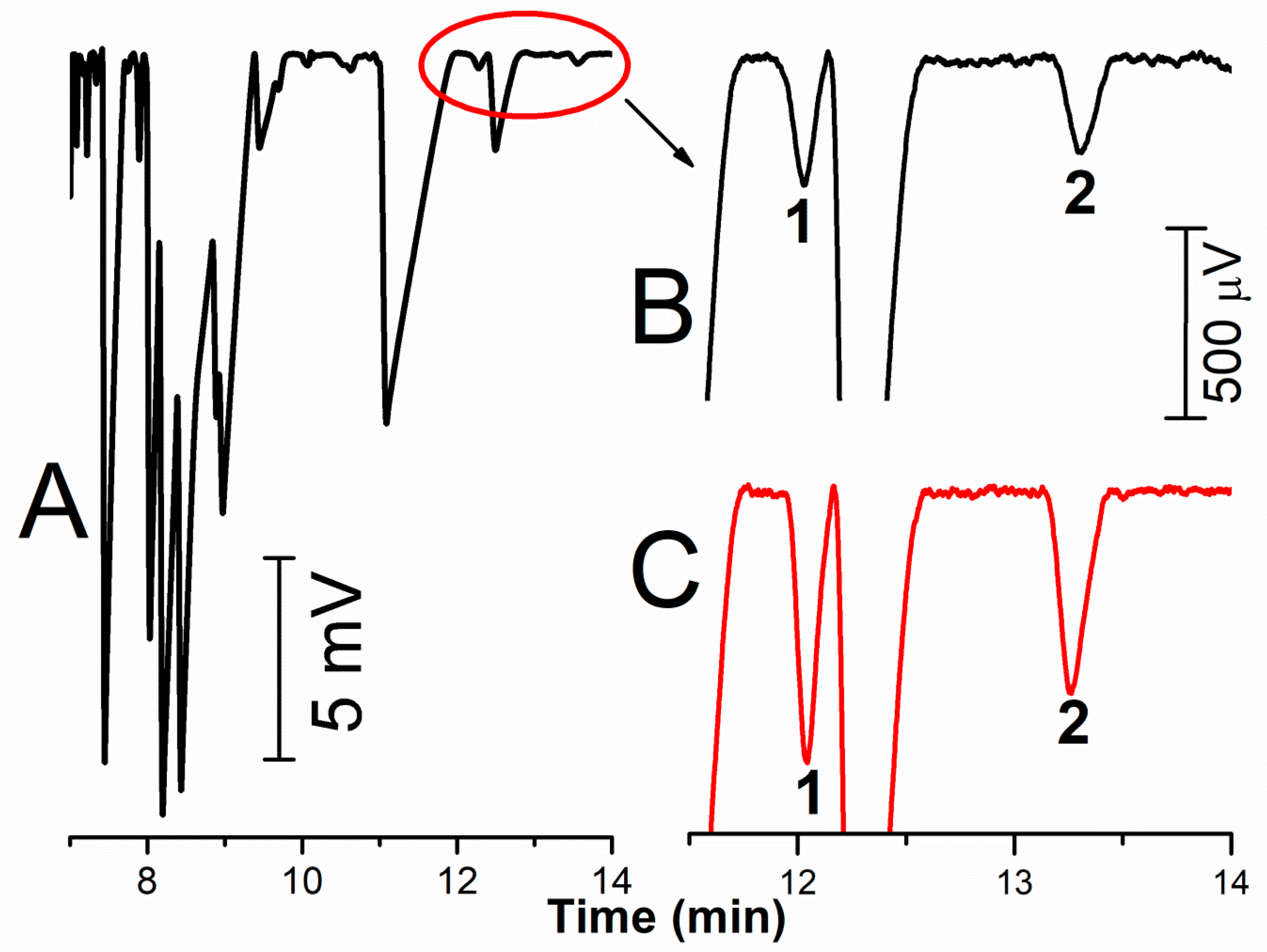
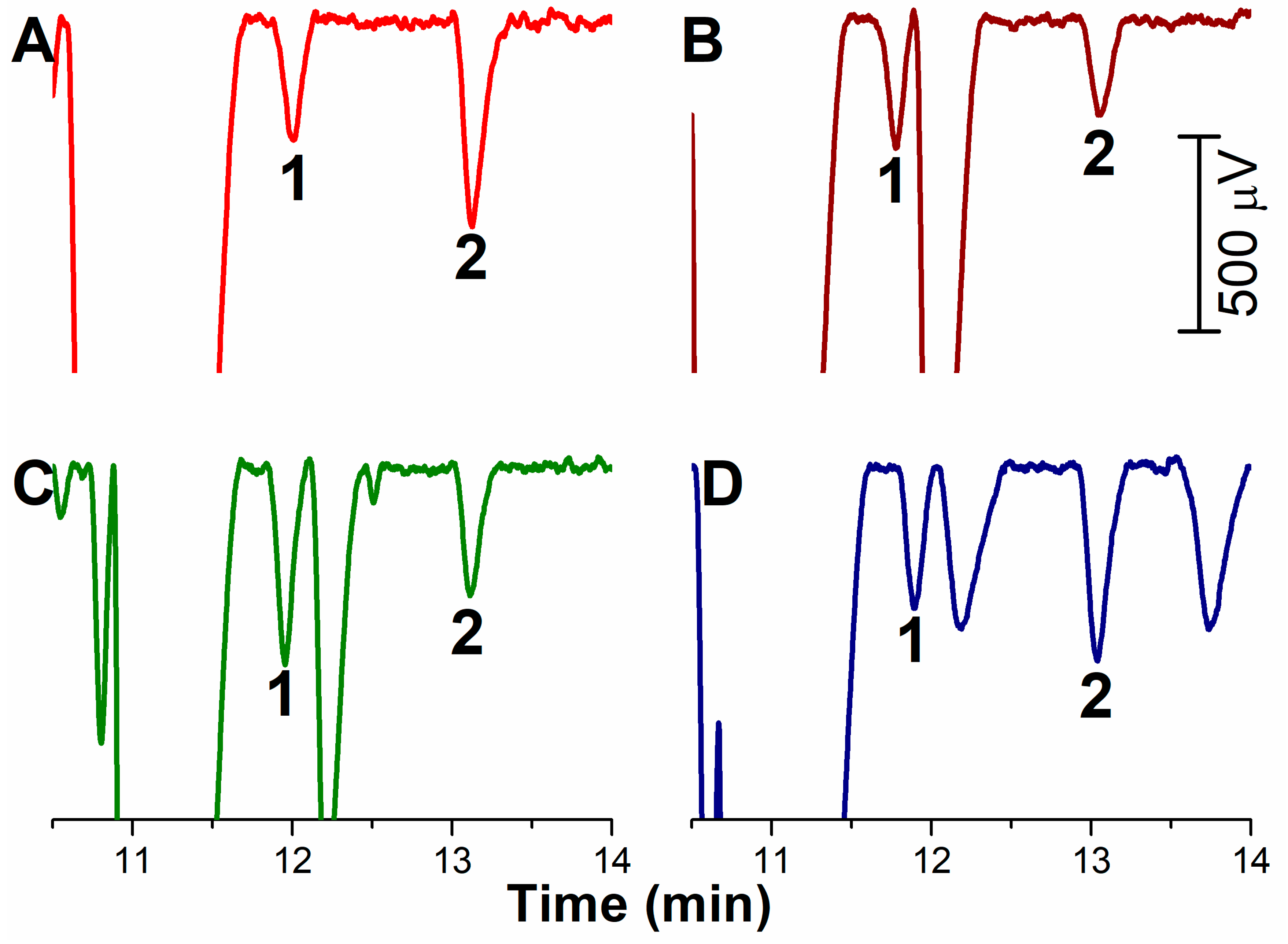

| Parameter | ADMA | SDMA |
|---|---|---|
| Concentration range, µM | 0.1–4.0 | 0.1–4.0 |
| Slope—Area, Mv·s/µM | 5.30 ± 0.05 | 5.86 ± 0.07 |
| R | 0.9997 | 0.9994 |
| Slope—Height, mV/µM | 0.95 ± 0.08 | 0.69 ± 0.08 |
| LOD, nM | 16 | 22 |
| LOQ, nM | 53 | 72 |
| Table 1000 | Derivatisation | Matrix | Treatment | tM, min | LOD *, nM | LOD **, nM | Ref. |
|---|---|---|---|---|---|---|---|
| CE-LIF | FITC | plasma | deproteinisation, 1000-fold dilution | 10 | 0.05 | 50 | [37] |
| CZE-UV | - | plasma | deproteinisation, 2-fold evaporation | 16 | 30 | 30 | [38] |
| CZE-UV-stacking | - | plasma | deproteinisation, evaporation | 22 | 10 | 10 | [41] |
| CZE-LIF | NDA | model | - | 8 | 20 | - | [44] |
| MCE-LIF | NDA | model | - | 3 | 70 *** | - | [44] |
| CZE-MS | - | model | - | 11 | 500 | - | [43] |
| CZE-MS-stacking | - | plasma | deproteinisation | 14 | 20 | 20 | [43] |
| CZE-LIF | NDA | plasma | heat-assisted SPE | 15 | 5–8 | 5–8 | [45] |
| CZE-C4D-stacking | - | plasma | deproteinisation | 14 | 16–22 | 16–22 | this paper |
| HPLC-FD | OPA | plasma | SPE, evaporation | 30 | 10 **** | 10 **** | [26] |
| HPLC-MS/MS | butyl ester | plasma | deproteinisation, evaporation | 1.6 | 0.5 | 2 **** | [28] |
| GC-MS | pentafluoropropionyl | plasma | deproteinisation, evaporation | 8.4 | - | 50 **** | [35] |
| ELISA | - | plasma | acylation, incubation | 20 h | - | 50 **** | [36] |
Publisher’s Note: MDPI stays neutral with regard to jurisdictional claims in published maps and institutional affiliations. |
© 2021 by the authors. Licensee MDPI, Basel, Switzerland. This article is an open access article distributed under the terms and conditions of the Creative Commons Attribution (CC BY) license (http://creativecommons.org/licenses/by/4.0/).
Share and Cite
Tůma, P.; Sommerová, B.; Koval, D.; Couderc, F. Electrophoretic Determination of Symmetric and Asymmetric Dimethylarginine in Human Blood Plasma with Whole Capillary Sample Injection. Int. J. Mol. Sci. 2021, 22, 2970. https://doi.org/10.3390/ijms22062970
Tůma P, Sommerová B, Koval D, Couderc F. Electrophoretic Determination of Symmetric and Asymmetric Dimethylarginine in Human Blood Plasma with Whole Capillary Sample Injection. International Journal of Molecular Sciences. 2021; 22(6):2970. https://doi.org/10.3390/ijms22062970
Chicago/Turabian StyleTůma, Petr, Blanka Sommerová, Dušan Koval, and François Couderc. 2021. "Electrophoretic Determination of Symmetric and Asymmetric Dimethylarginine in Human Blood Plasma with Whole Capillary Sample Injection" International Journal of Molecular Sciences 22, no. 6: 2970. https://doi.org/10.3390/ijms22062970
APA StyleTůma, P., Sommerová, B., Koval, D., & Couderc, F. (2021). Electrophoretic Determination of Symmetric and Asymmetric Dimethylarginine in Human Blood Plasma with Whole Capillary Sample Injection. International Journal of Molecular Sciences, 22(6), 2970. https://doi.org/10.3390/ijms22062970







